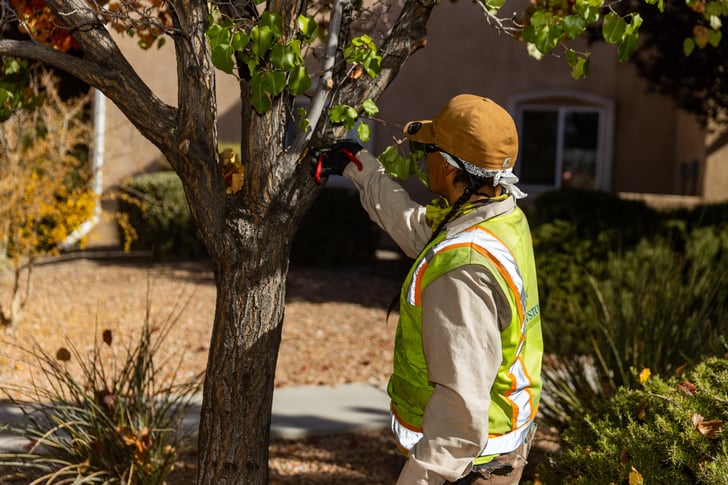Certain trees, like the mighty live oak, have durability and uniqueness built into their very nature. Ironically, this wildly popular tree species faces live oak disease threats that are exacerbated by human nature.
We’ll talk about ways to overcome that problem because protecting valuable live oaks on your commercial property means protecting your investment. If you’re considering planting new trees, this information will help you get literally hundreds of years of beauty and value from the installations.
After all, one of the reasons live oak trees are massively popular is their incredible longevity without needing tons of maintenance. They can stand up to brutal winds and thrive in various soil types. Plus, their unique visual appeal draws massive interest and has led to these trees having “recurring roles” in literature and art, especially in the southern U.S.
Live oaks are equipped to live long lives, but people play a key part in extending the lifespan of these gifts of nature. That’s why this article lays out the details you need to catch problems before they turn into live oak tree diseases. You’ll also see how one diseased tree can start a terrible domino effect.
Overview Of Live Oak Trees
Live oaks are most commonly planted in southern portions of the U.S., although California is home to a live oak species called Coast live oak.
The following states are where you’re most likely to enjoy the splendor of these iconic trees.
- Florida
- Georgia
- Texas
- Louisiana
- South Carolina
- North Carolina
- Virginia
- Mississippi
- Alabama
Most northern states are too frigid in winter for live oak trees to thrive. They also prefer humid climates, so arid states like New Mexico, Nevada, and Arizona aren’t ideal for these attractive additions to commercial and residential properties.
Regions with unsuitable environments miss out on the unique aesthetic appeal of gnarled branches, which grab attention and provide a home for over 100 bird species. Their canopy, full of handsome dark green leaves, provides massive shade, too, spreading as far as 120 feet wide and 80 feet tall!
Although live oak diseases present dangers, properly-cared-for live oaks usually live for about two centuries. Yet, some show astounding resilience, living for 500 to 1,000 years, (see the Seven Sisters Oak in Louisiana).
Live oaks’ staying power is part of the reason they’re so popular.
Another reason? They can thrive with minimal care since they’re so adaptable to various soil types and can fight off live oak diseases if properly planted and cared for in the early stages.
Unhealthy trees face an uphill battle, as you’re about to see.

Common Live Oak Tree Diseases
Let’s get into the causes, prevention, and treatment of various live oak tree diseases.
Oak Wilt
The starting point is identifying the symptoms. Cracking bark is a possible sign of trouble. Fungal mats (white felt-like material) underneath the bark are another indicator of Oak Wilt. Beetles can be attracted to this fungal material, too.
Other symptoms include:
- Brown streaks in the sapwood (the vital layer that carries water and nutrients to leaves)
- Leaf discoloration
- Premature leaf drop and thinning crown
What causes Oak Wilt? Bretziella fagacearum is the fungus that creates this live oak tree disease. 90% of new infections are caused by root grafts spreading from one tree to the next. Beetles contribute to spreading this disease, too.
Prevention: A comprehensive tree healthcare program is the foundation for disease prevention. Also, avoid pruning during the spring and early summer and use pruning paint to immediately seal tree wounds. Infected trees must be removed and properly disposed of to stop the spread. Beware of infected firewood (brought in for HOA community fire pits, for example).
How to treat Oak Wilt:
- Trenching (4-5 feet deep and 100 feet from “infection epicenter”) to cut off potential root connections that spread Oak Wilt
- Fungicide injections work best in the disease’s early stages
- Tree removal in severe cases
Hypoxylon Canker
Hypoxylon Canker is a serious live oak tree disease with symptoms such as:
- Thinning crown
- Smaller than normal leaves
- Dead limbs
- Bark splitting
- Tan cankers on branches and trunk
- White, stringy decay in the sapwood
What causes Hypoxylon Canker? A destructive fungus called Biscogniauxia atropunctata which takes advantage of stressed live oaks due to drought, soil compaction, flooding, pests, or damage to roots.
Prevention: The only cure is prevention with this deadly disease. Integrated pest management, proper irrigation, and ideal soil conditions help prevent trees from becoming stressed and vulnerable to fungal attacks. Proper pruning techniques and fertilization programs also reduce tree stress.
Limited treatment options:
- Remove severely infected trees to avoid more tree loss
- Prune infected branches in the early stages
Anthracnose
Symptoms of the tree disease Anthracnose include:
- Browning leaves or blotches
- Curling of leaf ends
- Springtime leaf drop
- Low twigs dieback
- Branch cankers
What causes Anthracnose? Apiognomonia quercina, another fungus, which thrives in cooler, damp weather. It can survive a cold winter and return to release harmful spores in the spring. Wet leaves benefit its life cycle, as does poor air circulation in individual live oaks or groups of trees.
Prevention: Proper leaf clean-up and disposal are simple ways to avoid Anthracnose, but prevention starts with proper spacing at the initial planting. This produces good air circulation—also aided through pruning by a certified arborist. Use deep-root watering and avoid overhead watering.
Treatment options for Anthracnose:
- Prune and remove infected branches from the property
- Use springtime fungicides before leaves break through the buds
- Comprehensive tree care strengthens the “immune system” of live oak trees
- Valuable trees can be treated with professional fungicide injections
Root Rot (Armillaria Root Rot)
Root Rot is a live oak tree disease that’s fairly easy to spot. Look for signs like:
- Mushrooms at tree base
- Yellowing of foliage
- Thinning canopy
- Fungal mats under bark near the ground
- Dark stringy material on roots
What causes Root Rot? The fungi labeled as Armillaria is another attacker of stressed trees. It finds opportunities to infect trees weakened by drought, soggy soil, construction damage, or pest infestation.
Prevention: Best practices like precisely measured irrigation and ensuring good soil drainage help prevent Root Rot. Professional tree inventories will help avoid root damage from construction or landscaping projects. Properly spaced tree installation and root barriers are also ideal preventatives for this live oak disease.
Limited Root Rot treatments:
- Prevent the spread by removing infected trees
- Early detection can save surrounding trees
The Biggest Threat to Healthy Trees
We realize it’s human nature to wait until problems arise and then look for a fix. That’s why we want to stress how vital disease prevention is with your most valuable landscape elements.
Waiting means you may be left with only one option—removing prized trees.
General Prevention Tips For Live Oak Tree Health
Now, let’s look at an overview of keeping live oak trees healthy. Then, we’ll show you some regional nuances.
Many people make the mistake of watering new trees too frequently. The ideal watering strategy is long, slow watering, but not every day. This mistake is even made by landscaping providers who haven’t been certified as expert arborists.
Next, mulching seems simple, but if not done properly, it can leave trees open to pests and disease. Roughly three inches of mulch is the right amount, but it shouldn’t be piled high at the tree’s base. Watch for standing water due to heavy rains washing mulch out too.
Other best practices include:
- Pruning at the right time of year
- Protecting trunks and roots from lawn equipment
- Aeration improves the soil for all plants, including trees
- Professional grade soil testing with proper fertilization
- Early pest detection (has saved many treasured live oaks)
Region By Region
Nuanced care comes into play in areas with numerous live oaks since the most likely infection comes by spreading via root systems. So, extra vigilance is needed in coastal Georgia areas, for example.
Commercial property owners in states susceptible to hurricanes are better prepared with live oaks, which naturally resist wind damage. Still, to get maximum wind protection in Florida landscapes, it’s important to follow proper tree planting procedures such as staking.
Lastly, central Texas is a hot spot for Oak Wilt, so it’s a must to get pruning done long before spring arrives.
These region-specific issues show how important having an experienced tree expert is for guidance on tree decisions that affect your overall landscape’s health.

Prevent Live Oak Disease with Professional Tree Care
Just one consultation with a professional arborist can save you from having to replace valuable live oaks and other special trees. The problem is too few landscaping providers have dedicated arborists on staff.
Yellowstone Landscape clients often tell us that’s one of the unique advantages of working with our local branches.
Not only do our full-time arborists provide the most modern and comprehensive tree healthcare available, they’re an asset to clients’ entire property. How?
When your trees are as healthy as possible, there’s less worry of devastating diseases and pest infestations. Plus, you’re adding a layer of protection from property damage and potential injuries that come with falling limbs or the entire tree.
With Yellowstone, you get premier landscape care and the same level of commercial tree care.
Our experience in comprehensive property care stretches nearly two decades, having served HOA communities across the nation, world-class resorts, and even cities hosting the Big Game.
Conclusion
We could talk about live oak trees all day long. They are one of the most unique trees we get the honor of caring for each week.
And now you have a better idea about locations that make ideal environments for this famous tree species. A drive through the southern United States is a worthwhile trip if only to sightsee streets lined with live oaks.
While these landscape elements are hardy and require minimal maintenance, learning about deadly live oak tree diseases can prevent major problems for you. The four we discussed were:
- Root Rot
- Anthracnose
- Hypoxylon Canker
- Oak Wilt
As we’ve seen, disease prevention is the best (often the only) option for protecting your valuable trees. Professional tree healthcare is the number one prevention strategy. And the cost is negligible considering these trees can add value to a property for over two hundred years.
That level of ROI is uncommon.
The returns are even more impressive, considering how healthy trees improve your entire landscape to create a vibrant property with lasting curb appeal.
If you have tree-related concerns or simply want to enhance your commercial property’s curb appeal, request a consultation with Yellowstone Landscape today.



